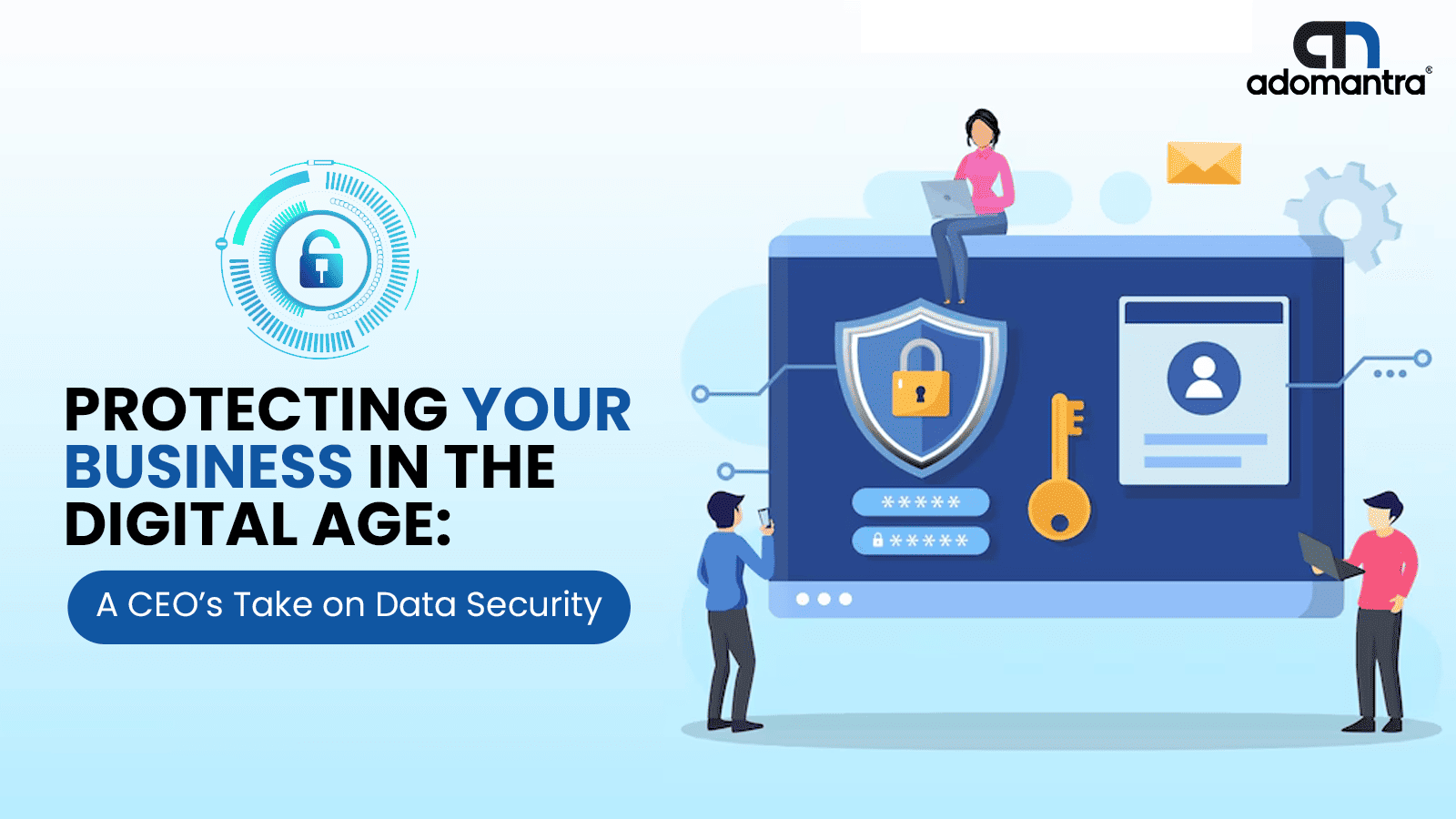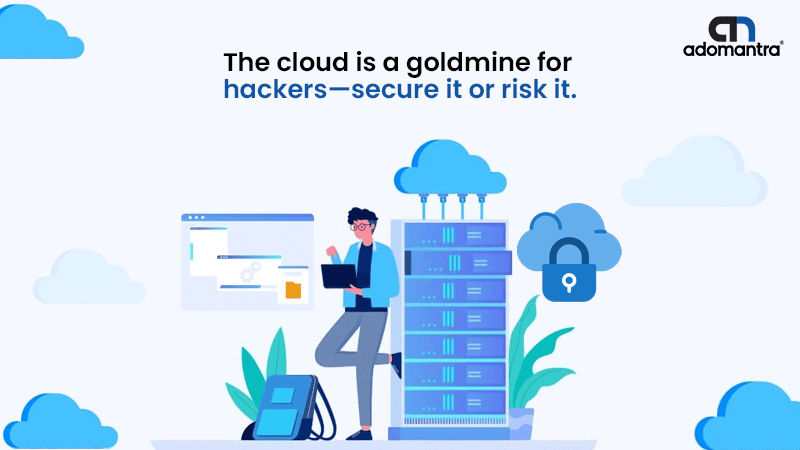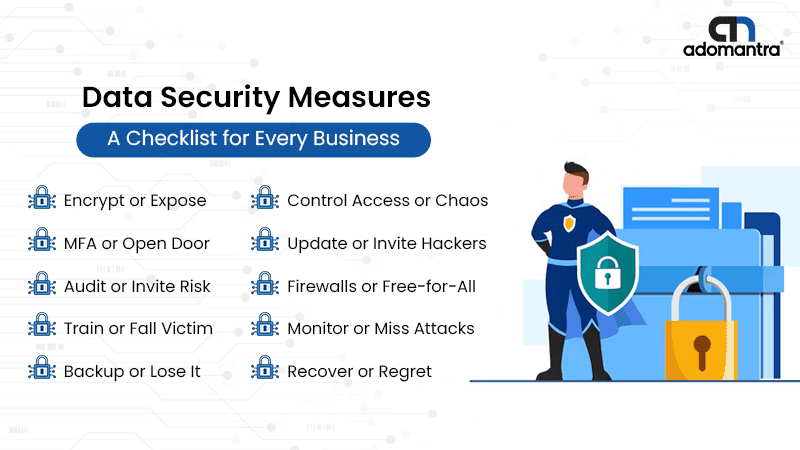
Data Security in the Digital Age: A CEO’s Perspective on Safeguarding Your Business
As the CEO of Adomantra, I’m constantly at the forefront of the digital revolution, watching the growing threats to data security in the digital age unfold. The pace at which technology evolves has made our lives easier, but it has also opened the door to a new breed of cybercriminals. It’s no longer a matter of if you will be targeted—it’s a matter of when. And the reality is that cybersecurity in the digital era is not just an IT concern; it’s now a core aspect of running a sustainable, trustworthy business.
Did you know that in 2024, data breaches cost businesses an average of $4.88 million globally, according to IBM Security’s annual report? That’s not a typo—it’s millions of dollars lost, and this figure continues to rise. The financial hit can be devastating, but it’s the loss of consumer trust and reputation damage that many businesses never fully recover from.
As companies, big or small, continue to digitize, we’re seeing an increasing number of vulnerabilities. Every time we innovate, we create potential entry points for hackers. Think about it—cloud storage, mobile apps, remote working, and even IoT devices are just a few examples of the digital infrastructure we rely on today. Yet, without the right data protection strategies, we’re essentially opening our doors to cybercriminals. So, let’s stay ahead of the curve and make digital data protection a priority, not an afterthought!
The Growing Threat of Cyber-Attacks: A Global Crisis

The digital era has brought immense benefits but also unprecedented challenges. Some of the examples of cyber threats in digital age are–
- In 2024, cybercrime was projected to cause damages totaling $9.5 trillion globally, a staggering increase from the $3 trillion recorded in 2015. (Cybersecurity Ventures)
- 50% of UK businesses experienced some form of cyber attack in 2023. (Cyber Security Breaches Survey)
- 79 million phishing attacks were recorded in India in 2023, ranking it as the third most targeted country globally. (NDTV)
- 1 in 2 American internet users had their accounts breached in 2021. (Statista)
- In 2023, India faced a 15% rise in cyber threats in the digital age. (Times of India)
- 236.1 million ransomware attacks occurred globally in the first half of 2022. (Cybersecurity Ventures)
- In the first four months of 2024, the Indian Cyber Crime Coordination Centre (I4C) registered 740,000 cyber crime cases. (Statista)
- 53.35 million US citizens were affected by cyber crime in the first half of 2022. (Statista)
- In 2023, nearly 1 billion emails were exposed globally, impacting 1 in 5 internet users. (Verizon Data Breach Investigations Report)
- In 2020, malware attacks increased by 358% compared to 2019. (Fortinet)
At Adomantra, we understand that securing business data isn’t just a necessity—it’s a responsibility. The rise of cloud computing, mobile devices, and the Internet of Things (IoT) has opened up new avenues for hackers to exploit.
In fact, 43% of cyber-attacks target small businesses, largely because they tend to have weaker security protocols in place. With the evolving digital landscape, businesses must adapt quickly to stay ahead of these growing threats.
What Happens When Data Security Fails? The Equifax Example
One of the most infamous data protection failures was the 2017 Equifax breach. It exposed the personal information of 147 million people and cost the company $4 billion in recovery and settlements. The cause? A failure to patch a known vulnerability.
This breach wasn’t just a technical failure—it was a failure of leadership. It highlights the importance of modern data security challenges and serves as a wake-up call for businesses to:
- Regularly patch vulnerabilities
- Apply multi-layered data protection strategies
- Train employees to reduce human error
See the Fortification of a Global E-Commerce Platform's Infrastructure
A few months ago, one of the world’s largest e-commerce platforms approached us for a digital data protection: their digital infrastructure was vulnerable to cyber-attacks. Despite handling millions of transactions daily, they struggled to protect sensitive customer data, payment details, and personal information.
After assessing their systems, we identified weak encryption, insecure cloud infrastructure, lack of multi-factor authentication, inadequate employee training, and inconsistent security audits. To address these issues, we upgraded encryption, strengthened cloud security, implemented MFA, and launched employee training programs on data protection. We also established regular security audits to ensure continuous protection.
Within six months, the company saw a 95% reduction in data breaches and a significant decrease in security risks. Today, they operate with a secure, fraud-free infrastructure, confidently serving their global customers.
Key Data Security Measures Every Business Should Take

Over the years, we’ve helped countless businesses implement robust security measures, and I want to share with you the most vital steps every company should take to stay protected in the digital age.
1. Encryption (The Backbone of Data Protection)
Encryption is the cornerstone of data security, and for good reason. It works by converting readable data into a scrambled format that can only be deciphered with a decryption key. In the event of a breach or unauthorized access, encrypted data is rendered completely useless to hackers.
Data at Rest: This refers to data stored on servers, databases, or other storage devices. Encrypting this data ensures that, even if physical storage is stolen, the data remains unreadable without the decryption key.
Data in Transit: Data transmitted over the internet or between systems can be intercepted by cybercriminals. Encrypting data in transit ensures that even if intercepted, it remains unintelligible and safe from prying eyes.
Without strong encryption, sensitive business information such as customer details, financial data, and intellectual property are all vulnerable to theft. In our work with clients, we make sure that data encryption is one of the first lines of defense we implement. The safety of your data starts here.
2. Multi-Factor Authentication (Adding a Critical Layer of Protection)
As someone who’s deeply invested in cybersecurity, I can tell you that relying on passwords alone is no longer enough. The introduction of multi-factor authentication (MFA) has become a game-changer in securing business systems.
MFA requires users to provide two or more forms of verification before gaining access to a system. These forms can include:
- Something you know: A password or PIN
- Something you have: A mobile phone, hardware token, or smartcard
- Something you are: Biometric data, such as a fingerprint or facial recognition
This extra layer of protection is essential. Even if a hacker manages to steal a password, they won’t be able to gain access without the second form of authentication. It’s a simple but highly effective step we take to minimize the risk of unauthorized access to our clients’ systems.
3. Regular Audits (Stay Ahead of Potential Threats)
Cyber threats evolve rapidly, and what was secure yesterday may be vulnerable today. That’s why regular security audits are vital to staying ahead of the game. I cannot stress enough how important it is to conduct both internal and external audits.
- Internal Audits: These audits examine your internal processes, employee access levels, and systems storing sensitive data. They help identify weaknesses, such as unnecessary permissions or outdated security protocols, that could put your business at risk.
- External Audits: External auditors simulate cyber-attacks to assess your security measures and uncover potential weaknesses that may be overlooked internally.
We encourage our clients to adopt a proactive approach to security by scheduling regular audits. This helps identify vulnerabilities before they can be exploited, allowing businesses to stay one step ahead of cybercriminals.
4. Employee Training (Strengthening the Human Element of Security)
While technology plays a crucial role in securing data, human error is often the weakest link in the chain. Cybercriminals frequently target employees through phishing attacks, social engineering, and weak password practices. That’s why employee training is so essential.
Training on Security Best Practices: At Adomantra, we conduct regular training sessions for employees, teaching them how to spot phishing emails, maintain strong passwords, and avoid risky online behavior.
Security Awareness Programs: We encourage businesses to establish security awareness programs that remind employees of the importance of data security and keep them updated on the latest threats.
Training isn’t a one-time event—it’s an ongoing process. Keeping employees informed about emerging threats and the best practices to mitigate those risks is an investment in your company’s long-term security.
5. Backup and Recovery Plan (Preparing for the Worst)
No system is entirely immune to cyber-attacks, and sometimes, despite all the right precautions, data breaches happen. That’s why having a solid backup and recovery plan is crucial. This step ensures that, even in the worst-case scenario, your business can recover quickly and resume operations with minimal disruption.
Regular Data Backups: We advise businesses to back up critical data regularly, ideally on a schedule. Storing backups in multiple locations, including offsite or in the cloud, provides an added layer of protection against data loss from physical damage or breaches.
Disaster Recovery Plan: A disaster recovery plan outlines the steps for restoring data and business operations after a breach or catastrophic event. It should identify which systems need to be restored first and how to maintain business continuity while doing so.
In our experience, businesses with robust backup and recovery plans minimize downtime and reduce the financial and operational impacts of a data breach or attack. The faster you can recover, the less damage you’ll experience.
Why Do These Measures Matter? The Importance of Data Security
In my career, I’ve seen the devastating impact that cyber-attacks can have on businesses—especially those that aren’t adequately prepared. According to a 2022 report by Cybersecurity Ventures, 60% of SMBs will shut down within six months after a cyber-attack. The reality is that no business, big or small, is exempt from the growing risk of data breaches.
Statistics tell us that 61% of data breaches are caused by external attacks, while 34% are the result of insider threats. And what’s even more concerning? 69% of breaches take months or longer to detect, meaning many businesses don’t even realize they’ve been compromised until it’s too late.
By taking proactive steps—such as implementing encryption, MFA, regular audits, employee training, and backup plans—your business can significantly reduce the risk of falling victim to a cyber-attack.
In Conclusion: Data Security Is Not Optional—It’s Essential
I believe that investing in data security is one of the most important decisions any business can make. The digital world may present many challenges, but with the right security measures in place, those challenges become manageable.
We have worked with companies across the globe to implement these measures and protect their data from evolving threats.
Don’t wait for a breach to occur—take action now.
If you need help securing your business, reach out to Adomantra.
Let’s ensure your data remains safe, your customers stay protected, and your business continues to thrive, free from the risk of cyber-attacks.






